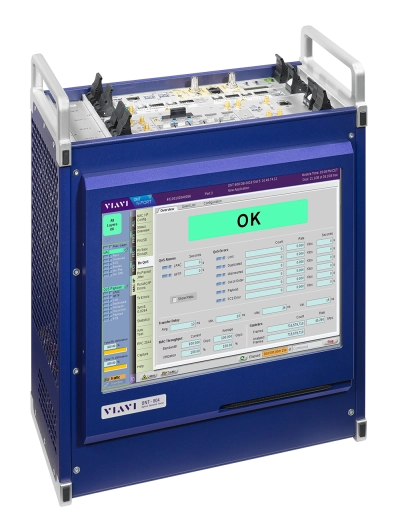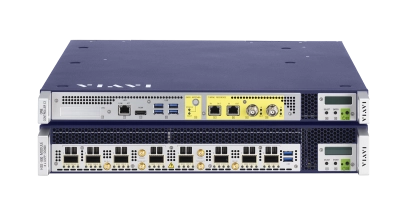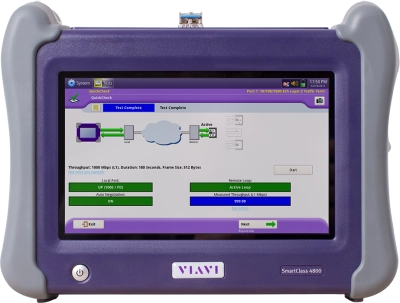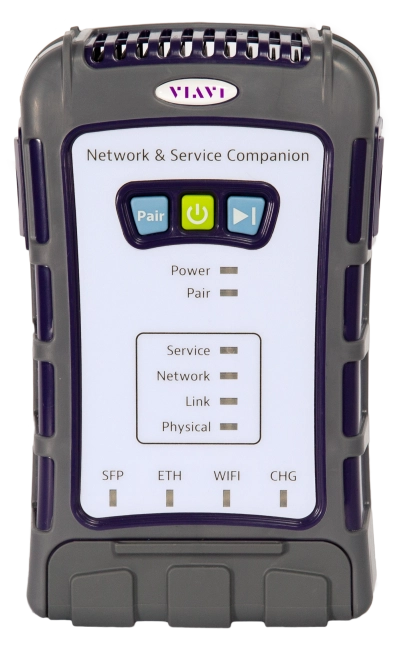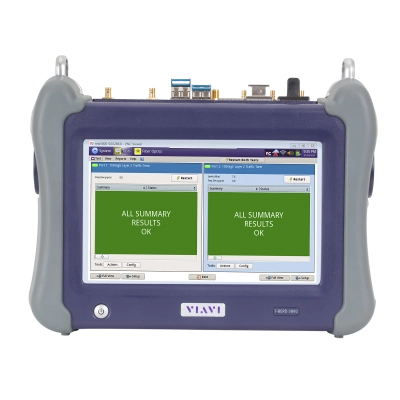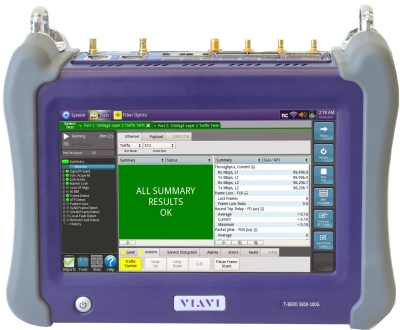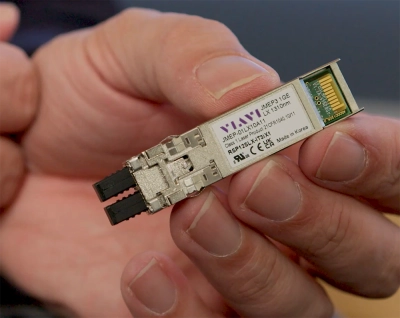Ethernet Test
Ethernet Test Solutions Spanning the Technology Lifecycle from Lab to Field
VIAVI Ethernet test solutions span the technology lifecycle from lab to field. This 360º view of the network landscape also incorporates the latest Ethernet test standards and innovations.
What is Ethernet Test?
Ethernet is a family of computer networking technologies used to connect local area networks (LAN), wide area networks (WAN), and metropolitan area networks (MAN) over twisted-pair or fiber optic cabling. The IEEE 802.3 standard defines the packet-based transfer mode of Ethernet. This technology has continued to evolve as top Ethernet speeds have gradually increased from 2.94 Mbps to 800 Gbps (800G).
Ethernet test practices focus on layers 2 and 3 of the network stack, as defined by the Open System Interconnect (OSI) model. Although it is useful to understand what is happening at the higher network layers, Ethernet testing targets the verification of lower layer performance.
-
Y.1564 and RFC 2544 test protocols have been developed to validate network service level agreements (SLAs) and quantify key performance indicators including throughput, latency, frame loss, and back-to-back frames (buffer operation) during Ethernet circuit characterization and service activation. These same standard tests can be used to troubleshoot post-activation issues.
-
RFC 6349 is a new methodology to measure Layer 4 transmission control protocol (TCP) traffic. It provides a reliable and repeatable method for testing end-to-end transfer performance. Transmission efficiency is determined based on factors including retransmission percentage and buffer delay. Co-authored by VIAVI, the RFC 6349 protocol measures outputs that directly impact the user’s web browsing experience.
-
The Two-Way Active Measurement Protocol (TWAMP) is another standards-based test method (RFC 5357) used to actively monitor Ethernet circuit performance. A TWAMP test setup can use many types of test points at the far end including a portable device, a small form pluggable, or even a software-based test agent.
-
VIAVI Ethernet Test Equipment incorporates the knowledge and insight garnered through decades of standards development participation and field experience gained alongside customers and manufacturers. This is reflected in versatile Ethernet test solutions for development teams, manufacturers, and live network applications. Sophisticated, high-density, rack-mounted Ethernet test equipment provides a common platform for design, system verification and manufacturing testing.
Compact, easy to use, and portable Ethernet network test devices and Ethernet cable test devices round out the portfolio by supporting the balance of the network lifecycle. The lab to field Ethernet testing philosophy adopted by VIAVI has yielded multi-technology, automated protocol testing in handheld devices along with scalable, high-density Ethernet test equipment and modules to accelerate development.
What is Ethernet Latency?
Latency is any delay in the network that slows down Ethernet packet transfer from source to destination. High performance Ethernet requires low and stable latency. Errors, physical distance, buffering issues, and switches all contribute to cumulative latency. As Ethernet speeds increase, there is a growing need for latency measurement and baselining of system components.
Nanosecond resolution, high precision, and accuracy are required for test solutions characterizing components and modules for 400G. Even minor changes in packet latency can disrupt the tuning and optimization of optical modules, integrated circuits (ICs), and other Ethernet network components.
Latency measurements performed in a lab environment can sometimes lack the network errors and other timing stressors that systems or components will experience in the real world. The VIAVI ONT family of Ethernet testing tool incorporates “stressed” latency testing and margin analysis to measure performance under more realistic conditions.
Ethernet Testing Use Cases
Ethernet use cases continue to expand as 5G x-haul networks incorporate high speed packet-based Ethernet technology into their architecture. Ethernet test solutions must continually adapt to the needs of service providers, developers, manufacturers, and enterprises.
Lab & Manufacturing
VIAVI ONT Ethernet test tools help you develop and validate the integrated circuit (IC), modules, and network elements needed for Ethernet. Our solutions validate to 800Gb class Ethernet systems with nanosecond precision visibility, full control of the PAM-4, and FEC domain. ONT Ethernet test tools are for anyone involved with development and lab work.
-
FlexE is a client interface that allows for connectivity between devices independent of the physical interfaces. FlexE utilizes link bonding, sub-rating, and channelization to match service rates to flexible line rates. Flexible Ethernet is among the new technologies requiring innovative speed test ethernet connection methods for R&D and manufacturing.
-
PAM-4 is a “higher order” modulation required to achieve 400 Gbps transmission rates and higher. Four distinct levels are used to encode two bits of data, versus only two for traditional NRZ modulation. The extra layers double the bandwidth but add more errors to the transmission. The “always errored” transmission may fall within an acceptable range only if mitigated by another technology, Forward Error Correction (FEC). FEC provides a measure of error control in a transmission via the transmitter sending redundant data while the receiver recognizing only the portion of the data that contains no apparent errors.
-
The VIAVI ONT family of optical transport test solutions address the test complexity of “always errored” PAM-4 encoding, forward error correction (FEC), and ultra-fast Ethernet line rates. The ONT-800 optical network test platform and advanced test modules, like the 800G FLEX XPM module and the ONT N-PORT module, enable designers and manufacturers to emulate complex traffic patterns and anomolies and validate first generation 400G and 800G pluggable modules. FlexE software tools can be used to develop and verify FlexE shim functions.
-
The Rise of DCO Pluggable Optics: Network providers are currently facing a tsunami of traffic, a wave even rapid build-out cannot outpace. Coherent optics promise to be the savior, by taking the typical ones and zeroes in a digital signal and using sophisticated technology to modulate the amplitude and phase of that light to send a signal across each of two polarizations. The result is substantially more information packed onto the light travelling through a fiber optic cable.
- Pluggable Coherent for Ethernet: Emerging applications such as datacenter interconnect DCI are driving the use of pluggable coherent modules for Ethernet, especially at 400GE. The increased complexity of managing, developing, integrating, and operating these modules presents new challenges over and above high-speed Ethernet. VIAVI have considerable expertise with pluggable coherent optics over the complete lifecycle, including ZR optics.
- The VIAVI ONT family of optical transport test solutions address the test complexity of ultra-fast Ethernet line rates. The ONT-800 optical network test platform and advanced test modules, like the 800G FLEX XPM module and the ONT N-PORT module, enable designers and manufacturers to emulate complex traffic patterns and anomalies and validate first generation 400G and 800G pluggable modules. FlexE software tools can be used to develop and verify FlexE shim functions.
Service Providers
Ethernet Business Services (EBS) is a market segment that is often the most profitable and fastest-growing for service providers. Providing a great customer experience for this valuable segment is critical. This begins with a rock-solid, network performance KPI baseline when the service is activated, which requires an advanced Ethernet testing tool running standards-based tests. A well-rounded test suite must include RFC 2544, Y.1564, RFC 6349, and PTP/1588v2 timing and synchronization testing.
-
Multiple Network Protocols. The installed base of the average service provider includes many different circuit types including TDM/PDH, SONET, SDH, and Fiber Channel, in addition to Ethernet. Fortunately, this does not mean technicians need to carry and manage more test gear. VIAVI has expertly packed test capabilities for all the transmission protocols into singular, compact test instruments that easily guide users through the multiple test procedures. The versatile VIAVI TBERD/MTS-5800 and TBERD/MTS-5800 100G test units feature industry-leading test coverage.
-
Remote Network Monitoring is among the trends providing greater convenience for Ethernet service providers. The VIAVI MAP-2100 is a rack-mounted 100G Ethernet tester that has been developed specifically for remote BERT test for Ethernet to unmanned locations. All VIAVI metro test instruments can be accessed remotely via a smart phone app, allowing an expert to consult with a technician onsite during a test, or to simply perform a test remotely.
-
Virtual Service Activation has become a necessity with the arrival of nimble software defined networks (SDNs) and network function virtualization (NFV). To prevent the test function from being left behind by these dynamic networks, VIAVI has virtualized the network test function to keep pace.
Part of the VIAVI NITRO platform, Fusion is a centralized, software-based test system for service activation and ongoing assurance of virtual and hybrid networks. All VIAVI metro test instruments can also be used as test endpoints. Fusion can integrate any combination of software-based test agents and physical test devices into one unified system.
Enterprise
Enterprises networks for regional banks, colleges, hospitals, and many other industries rely on Ethernet to distribute mission-critical applications and provide access to cloud-based resources. Degraded Ethernet performance can impact operations where network downtime is not acceptable.
-
Network Service Providers are responsible for troubleshooting and resolving Ethernet issues. Without the ability to take transmission measurements remotely, they are often forced to dispatch technicians to remote locations. Providing enterprise network managers with the right Ethernet tester or Ethernet cable tester reduces dependance on service providers for performance monitoring and can help to kickstart the troubleshooting process before the service provider arrives.
-
A handheld Ethernet tester can complete many of the same standards-based throughput tests performed by service providers over a compact and easy-to-use interface. The Network and Service Companion (NSC-100) uses the VIAVI ‘OneCheck’ application to perform high-speed Ethernet network validation at the push of a button. Options for PON and WiFi network testing are also included. VIAVI Fusion (centralized test system) can also leverage NSCs as remote-controlled test agents.
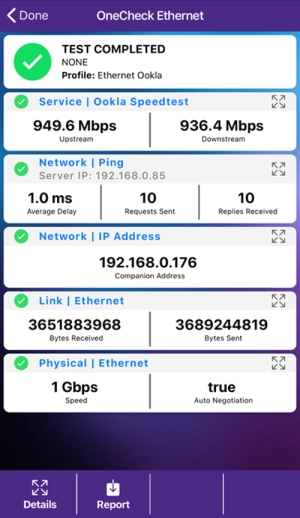
-
Advanced Ethernet test capabilities can be found in a portable Ethernet testing tool to empower enterprise network managers and service technicians alike. The SmartClass 4800 includes features like TrueSpeed testing per RFC 6349 and voice quality testing (VoIP or PRI) over an intuitive interface.
Ethernet Testing FAQ
- How Do You Test an Ethernet Connection?
Understanding how to test an Ethernet connection correctly extends from the physical layer (media and technology) to advanced frame performance metrics and burst testing. Verification of fiber-based cabling using an Ethernet cable tester and fiber inspection tools like the P5000i Fiber Microscope are recommended first steps and basic practices.
A J-QuickCheck “pre-test”, which can be integrated within an RFC 2544/Y.1564 test flow, quickly diagnoses any basic connectivity issues, mismatched ports, or other Ethernet configuration issues. Once connectivity is established, service activation testing can then be performed to quantify throughput, latency, packet jitter, and frame loss.
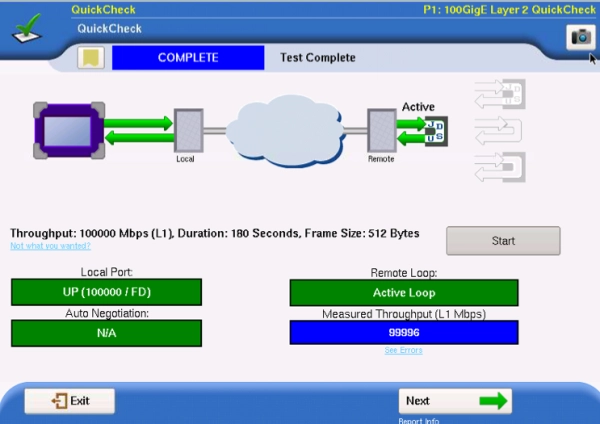
The RFC 2544 protocol is the industry standard for single-service Ethernet activation testing. The Y.1564 test protocol supports multi-service Ethernet and IP (e.g. “Triple Play”). More advanced RFC 6349 protocol testing can also be performed to ensure network efficiency and KPIs are acceptable. Burst testing will uncover how well the network performs under more variable or unexpected traffic conditions.
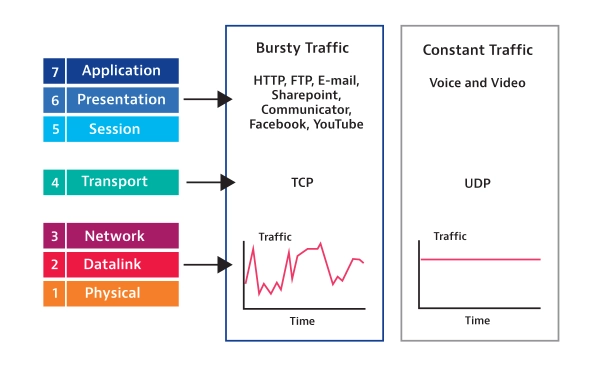
-
How Do You Test FlexEthernet (FlexE)?
FlexE allows operators to dynamically program Ethernet line rates, optimize network efficiency, and enable software defined networks (SDN). Programmable, next-generation transport networks require a new breed of Ethernet tester to launch FlexE products faster and ensure interoperability.
The ONT FlexE software options allow equipment manufacturers and operators to create test cases for FlexE client setup, calendar mapping, and overhead manipulation. A long list of Shim Alarms and errors can be introduced to test system logic and interoperability between network elements.
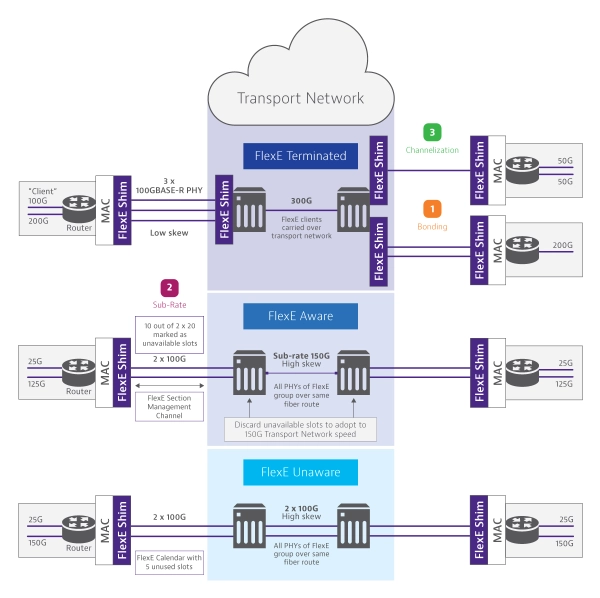
- What Ethernet Speeds Can VIAVI Test?
Ethernet network speeds have continued to rise as the transport technology improves. VIAVI Ethernet tester solutions support standards-based testing for all available Ethernet speeds, ranging from 10G to 400G. Key line rates including 25G, 26G, and 50G are also fully supported.
- What Types of Ethernet Tests Do VIAVI Ethernet Testers Support?
VIAVI provides the solutions that define how to test an Ethernet connection. A winning combination of field experience, standards development, and cutting-edge technology have resulted in an industry-leading selection of Ethernet cable testing equipment.
Industry standard Y.1564, RFC 2544, and RFC 6349 test capabilities are available in a variety of user-friendly platforms. Compact Ethernet test probes, Ethernet loopback test software, FlexE test software, and remote monitoring solutions round out the complete “lab to field” Ethernet test portfolio.
Suivi à chaque étape
Nous assurons l’assistance, les services, des formations complètes ainsi que les ressources qu’il vous faut. Tout cela dans le but de maximiser la valeur de vos investissements VIAVI.
Interrogez un expert
Contactez-nous pour de plus amples informations ou pour recevoir un devis. Nos experts sont là pour répondre à toutes vos questions.

